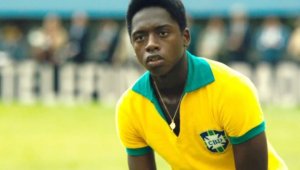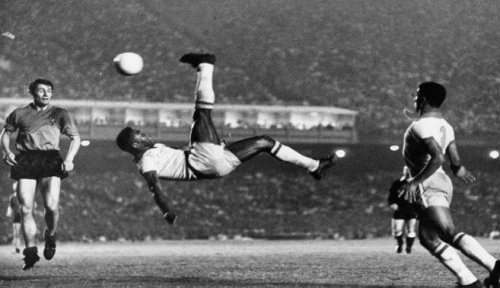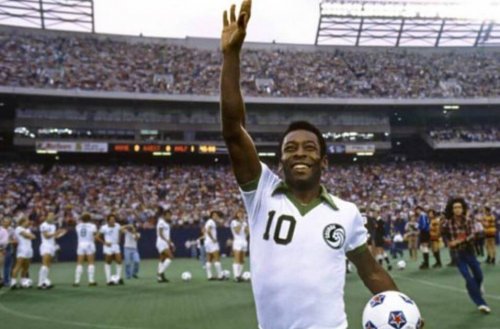Pele: the king of soccer

Brazil is the clear leader in the history of soccer World Cup championships. If there’s a player who represents a good part of the history of Brazilian soccer, full of wonderful figures, it’s Pele. “The King”, as he’s nicknamed, knew how to shine in the big events and got to raise three World Cup trophies with his home team.
Edson Arantes do Nascimento, better know as Pele, was born on October 23, 1940, in Tres Coracoes, in the state of Minas Gerais. Being the son of a soccer player, his passion for this game was ignited from childhood. Nothing strange considering the Brazilian idiosyncrasy, of course.
What does stand out is that only 18 years later, this boy and his national team would raise the first World Cup won by this country, in Sweden 1958.
It would be the beginning of a dream trajectory with the “verdeamarelha” shirt. He was able to repeat the feat in Chile in 1962 and in Mexico in 1970. These were the first global achievements for Brazil, which later added the World Cups held in the United States and Korea-Japan in 1994 and 2002, respectively. Pele has won this trophy more times than anybody.
Moreover, he accumulated many honors from sports and social entities, non-governmental organizations, and news media. In a time when the famous Golden Ball didn’t exist (which he would’ve won), he was elected Best Young Player by FIFA in 1958, World Citizen by the UN in 1977, and Best Player of the 20th Century, also by FIFA, in the year 2000, among many other awards.

How did Pele play?
What stands out the most in the Brazilian idol is that he was a very complete player. He was skillful, strong, and fast. To a large extent, these three virtues explain the incredible amount of goals that he scored throughout his career, which we’ll look into later.
These are the innate characteristics of this soccer star:
- Speed: it’s enough to view his fantastic plays for a few minutes to notice that Pele had more speed than his opponents. He would always arrive before everyone, leaving them all behind. Although we can’t compare the physical preparation of that time to the current one, “the King” clearly stood out.
- Power: besides being very fast, Pele was also strong. He would protect the ball like no other and this made it very difficult to take it from him. His unbridled sprints towards the rival goal post show how the defenders couldn’t stop him, despite the attempts.
- Dribbling: there are almost no Brazilian strikers who don’t have this gift. However, Pele was outstanding at it. Beyond his endless feints, he had a characteristic move: throw the ball over his rivals and look for it on the lateral side to continue his unstoppable path to the goal. Another play that remains in history is his feint to the goalkeeper of Uruguay in 1970. Unfortunately, that ball didn’t want to go in.
- Scorer: mathematical discussions aside, Pele has been a wonderful scorer, both in the Santos and his national team. He had an extreme capacity to score. Moreover, many of these goals were true works of art with defenders and goalkeepers on the floor while the ball slipped into the net.

How many goals did he score?
Pele has self-proclaimed many times that he exceeded a thousand goals. However, that’s partially true. He did surpass that mark, but only if we consider goals from friendly and unofficial matches.
The Brazilian says he has scored 1,274 goals. Nonetheless, according to a complete report on the subject, from an Argentinian sports magazine, the many official goals are divided as follows:
- 643 in the Santos.
- 37 in the United States Cosmos
- 77 in Brazil’s national team
The goals that weren’t scored in official tournaments were also copious:
- 446 in friendly matches with the Santos.
- 26 in friendlies with the Cosmos.
- 9 in a state team from San Pablo.
- 6 in a collective team between Santos and Vasco da Gama.
- 18 in exhibition matches with Brazil’s national team.
- 3 for the San Pablo Athletes Union.
- 5 in benefit matches.
- 14 goals for the Brazilian Army in an exhibition to which he was invited.
Finally, after counting all the official goals, Pele occupies the third position in the historical table. Only Romario with 772 goals and Josef Bican with 805 out rank him.
National soccer icon
The Santos, a club based in the city of the same name in the State of Sao Paulo, has the privilege to say that Pele carried out almost all his sports career wearing their shirt. He defended it from 1956 to 1975. Today, omitting a few not-so-brilliant exceptions, this is an unimaginable fact, which only multiplies the significance of Pele’s legacy for Brazilian soccer.
After his first retirement with the Vila Belmiro club shirt, he decided to return to the field, tempted by the American Cosmos FC. The decision was driven by bad investments that almost led him to bankruptcy.
He would go on to play for three years in the north part of the American continent. They went from worse to better, both he and his team. In 1977, Pele’s last championship as a player, the Cosmos was crowned champion of the American League.
His farewell match was a friendly game between Santos and Cosmos. Pele played a half time for each team.
The years have passed by and Pele continues to occupy a place on the podium of the best in history. He is accompanied by Maradona, with whom he has a famous tough struggle over who occupies the first place in the history of soccer. Lurking around both figures we find other kings such as Messi, C. Ronald, Cruyff, or Di Stefano. The order of who is better is up to everyone’s criteria, but Pele will always be a candidate.
Brazil is the clear leader in the history of soccer World Cup championships. If there’s a player who represents a good part of the history of Brazilian soccer, full of wonderful figures, it’s Pele. “The King”, as he’s nicknamed, knew how to shine in the big events and got to raise three World Cup trophies with his home team.
Edson Arantes do Nascimento, better know as Pele, was born on October 23, 1940, in Tres Coracoes, in the state of Minas Gerais. Being the son of a soccer player, his passion for this game was ignited from childhood. Nothing strange considering the Brazilian idiosyncrasy, of course.
What does stand out is that only 18 years later, this boy and his national team would raise the first World Cup won by this country, in Sweden 1958.
It would be the beginning of a dream trajectory with the “verdeamarelha” shirt. He was able to repeat the feat in Chile in 1962 and in Mexico in 1970. These were the first global achievements for Brazil, which later added the World Cups held in the United States and Korea-Japan in 1994 and 2002, respectively. Pele has won this trophy more times than anybody.
Moreover, he accumulated many honors from sports and social entities, non-governmental organizations, and news media. In a time when the famous Golden Ball didn’t exist (which he would’ve won), he was elected Best Young Player by FIFA in 1958, World Citizen by the UN in 1977, and Best Player of the 20th Century, also by FIFA, in the year 2000, among many other awards.

How did Pele play?
What stands out the most in the Brazilian idol is that he was a very complete player. He was skillful, strong, and fast. To a large extent, these three virtues explain the incredible amount of goals that he scored throughout his career, which we’ll look into later.
These are the innate characteristics of this soccer star:
- Speed: it’s enough to view his fantastic plays for a few minutes to notice that Pele had more speed than his opponents. He would always arrive before everyone, leaving them all behind. Although we can’t compare the physical preparation of that time to the current one, “the King” clearly stood out.
- Power: besides being very fast, Pele was also strong. He would protect the ball like no other and this made it very difficult to take it from him. His unbridled sprints towards the rival goal post show how the defenders couldn’t stop him, despite the attempts.
- Dribbling: there are almost no Brazilian strikers who don’t have this gift. However, Pele was outstanding at it. Beyond his endless feints, he had a characteristic move: throw the ball over his rivals and look for it on the lateral side to continue his unstoppable path to the goal. Another play that remains in history is his feint to the goalkeeper of Uruguay in 1970. Unfortunately, that ball didn’t want to go in.
- Scorer: mathematical discussions aside, Pele has been a wonderful scorer, both in the Santos and his national team. He had an extreme capacity to score. Moreover, many of these goals were true works of art with defenders and goalkeepers on the floor while the ball slipped into the net.

How many goals did he score?
Pele has self-proclaimed many times that he exceeded a thousand goals. However, that’s partially true. He did surpass that mark, but only if we consider goals from friendly and unofficial matches.
The Brazilian says he has scored 1,274 goals. Nonetheless, according to a complete report on the subject, from an Argentinian sports magazine, the many official goals are divided as follows:
- 643 in the Santos.
- 37 in the United States Cosmos
- 77 in Brazil’s national team
The goals that weren’t scored in official tournaments were also copious:
- 446 in friendly matches with the Santos.
- 26 in friendlies with the Cosmos.
- 9 in a state team from San Pablo.
- 6 in a collective team between Santos and Vasco da Gama.
- 18 in exhibition matches with Brazil’s national team.
- 3 for the San Pablo Athletes Union.
- 5 in benefit matches.
- 14 goals for the Brazilian Army in an exhibition to which he was invited.
Finally, after counting all the official goals, Pele occupies the third position in the historical table. Only Romario with 772 goals and Josef Bican with 805 out rank him.
National soccer icon
The Santos, a club based in the city of the same name in the State of Sao Paulo, has the privilege to say that Pele carried out almost all his sports career wearing their shirt. He defended it from 1956 to 1975. Today, omitting a few not-so-brilliant exceptions, this is an unimaginable fact, which only multiplies the significance of Pele’s legacy for Brazilian soccer.
After his first retirement with the Vila Belmiro club shirt, he decided to return to the field, tempted by the American Cosmos FC. The decision was driven by bad investments that almost led him to bankruptcy.
He would go on to play for three years in the north part of the American continent. They went from worse to better, both he and his team. In 1977, Pele’s last championship as a player, the Cosmos was crowned champion of the American League.
His farewell match was a friendly game between Santos and Cosmos. Pele played a half time for each team.
The years have passed by and Pele continues to occupy a place on the podium of the best in history. He is accompanied by Maradona, with whom he has a famous tough struggle over who occupies the first place in the history of soccer. Lurking around both figures we find other kings such as Messi, C. Ronald, Cruyff, or Di Stefano. The order of who is better is up to everyone’s criteria, but Pele will always be a candidate.
All cited sources were thoroughly reviewed by our team to ensure their quality, reliability, currency, and validity. The bibliography of this article was considered reliable and of academic or scientific accuracy.
- Melón De Oro. (2019, 15 julio). (Nuevo) Lo mejor de Pelé – Mejores jugadas del Rey Pelé [Vídeo]. YouTube. https://www.youtube.com/watch?v=MGtBC0S4BIQ
This text is provided for informational purposes only and does not replace consultation with a professional. If in doubt, consult your specialist.








